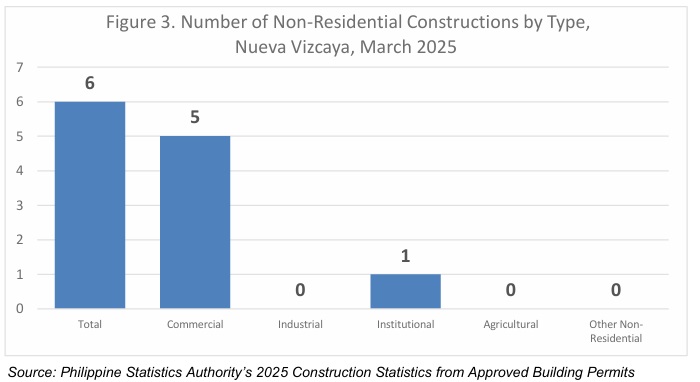Total number of constructions from approved building permits tripled in March 2025.
For March 2025, Nueva Vizcaya total number of constructions from building permits was posted at 22 constructions, 214.29 percent higher compared to 7 tallied constructions in the same period of 2024.
Out of the 22 construction projects in the province, 16 of them were residential and 6 were non-residential. The number of residential constructions increased significantly, from 2 in March 2024 to 16 in 2025, a 700 percent increase. Meanwhile, non-residential construction slightly increased by 20 percent, rising from 5 constructions in 2024 to 6 constructions in 2025. (Figure 1)

Floor area, value and average cost per square meter for residential construction notably increased.
The total number of residential constructions in Nueva Vizcaya for March 2025 increased significantly to 16 compared to only 2 constructions in 2024. The total floor area also grew sharply from 397 square meters in 2024 to 3,831 square meters in 2025, reflecting an increase of 864.99 percent.
Correspondingly, the total value of residential constructions expanded from PhP 3.798 million in March 2024 to PhP 55.797 million in the same month of 2025, representing a growth of 1,369.11 percent. Additionally, the average cost per square meter increased from Php 9,566.75 to PhP 14,564.60, marking an increase of 52.24 percent. This shows higher spending on construction foe each square meter. (Table 1)

All of the residential constructions are single-type houses.
For March 2025, all residential constructions, 16 out of 16 constructions, from approved building permits in Nueva Vizcaya, were classified as single-type houses. This highlights a uniform residential construction trend, with no recorded activity for duplex/quadruplex, apartment/accessoria, residential condominium, or other residential types. (Figure 2)

Non-residential construction’s floor area increased, but value and average cost per square meter declined.
Non-residential construction in Nueva Vizcaya for March 2025 recorded a total of 6 from the 5 projects recorded in 2024. The total floor area expanded by 97.40 percent, jumping from 615 square meters in 2024 to 1,214 square meters in 2025.
However, despite the rise in both the number of projects and the floor area, the total value of non-residential construction dropped by 5.66 percent, decreasing from PhP 11.688 million in March 2024 to PhP 11.027 million in the same period of 2025.This decline in value combined with the increase in floor area, resulted in a 52.20 percent decrease in the average cost per square meter, from PhP 19,004.88 to PhP 9,083.20. (Table 2)

Majority of the non-residential constructions are Commercial Structures.
Commercial structures comprise most of the number of non-residential constructions in Nueva Vizcaya, accounting for 83.33 percent or five out of six total constructions. The remaining one construction, or 16.67 percent, was classified as an institutional structure. There were no data tallied under the industrial, agricultural, and other non-residential construction. (Figure 3)

Technical Notes
The definition of term is adopted from the Revised and Updated Implementing Rules
and Regulations of the National Building Code.
Building Permit is a written authorization granted by the LBO to an applicant allowing him to proceed with the construction of specific project plans after plans, specifications, and other pertinent documents have been found to be in conformity with the National Building Code.
Building refers to any independent, free-standing structure comprised of one or more rooms or other spaces, covered by a roof and enclosed with external walls or dividing walls, which extend from the foundation to the roof.
Construction refers to all on-site work done from site preparation, excavation, foundation, assembly of all the components and installation of utilities, machineries, and equipment of buildings/structures.
Residential building is a building for which its major parts or more than half of its gross floor area is built for dwelling purposes. This type of building can be of the single type, duplex, apartment and/or accessoria, and residential condominium.
Single house is a complete structure intended for a single family or household, i.e., bungalow, 2-storey house, nipa hut, etc.
Duplex house is a structure intended for two households, with complete living facilities for each; it is a single structure divided into two dwelling units by a wall extending from the floor to the ceiling.
Apartment is a structure, usually of two storeys, made up of independent living quarters, with independent entrances from internal walls and courts.
Accesoria is a one or two-floor structure divided into several dwelling units, each dwelling unit having its own separate entrance from the outside.
Residential condominium is a structure, usually of several storeys, consisting of multiple dwelling units.
Other residential construction consists of school or company staff houses, living quarters for drivers and maids, and guardhouses.
Non-residential buildings include commercial, industrial, agricultural, and
institutional buildings.
Commercial buildings refer to office buildings and all buildings which are
intended for use primarily in wholesale, retail, and service trades; i.e., stores,
hotels, restaurants, banks, disco houses, etc.
Industrial buildings are buildings used to house the production, assembly,
and warehousing activities of industrial establishments; i.e., factories, plants,
mills, repair shops, machine shops, printing press, storage plants, electric
generating plants.
Institutional buildings are buildings which are primarily engaged in providing
educational instructions and hospital/health care; ports, airports and other government buildings; i.e., schools, museums, libraries, sanitaria, churches, hospitals.
Agricultural buildings are buildings used to house livestock, plants, and agricultural products such as barns, poultry houses, piggeries, stables,
greenhouses, and grain mills.
Other non-building constructions include cemetery structures, street
furniture, waiting sheds, communication towers, etc.
Floor area of building refers to the sum of the area of each floor of the building measured to the outer surface of the outer walls including the area of lobbies, cellars, elevator shafts, and all communal spaces in multi-dwellings. Areas of balconies are excluded.
Total value of construction refers to the sum of the cost of building, electrical,
mechanical, plumbing, and others. The value is derived from the approved building
permit and represents the estimated value of the building or structure when
completed.
SGD
ENGR. JOEL P. BASCO
(Supervising Statistical Specialist)
Officer-In-Charge
